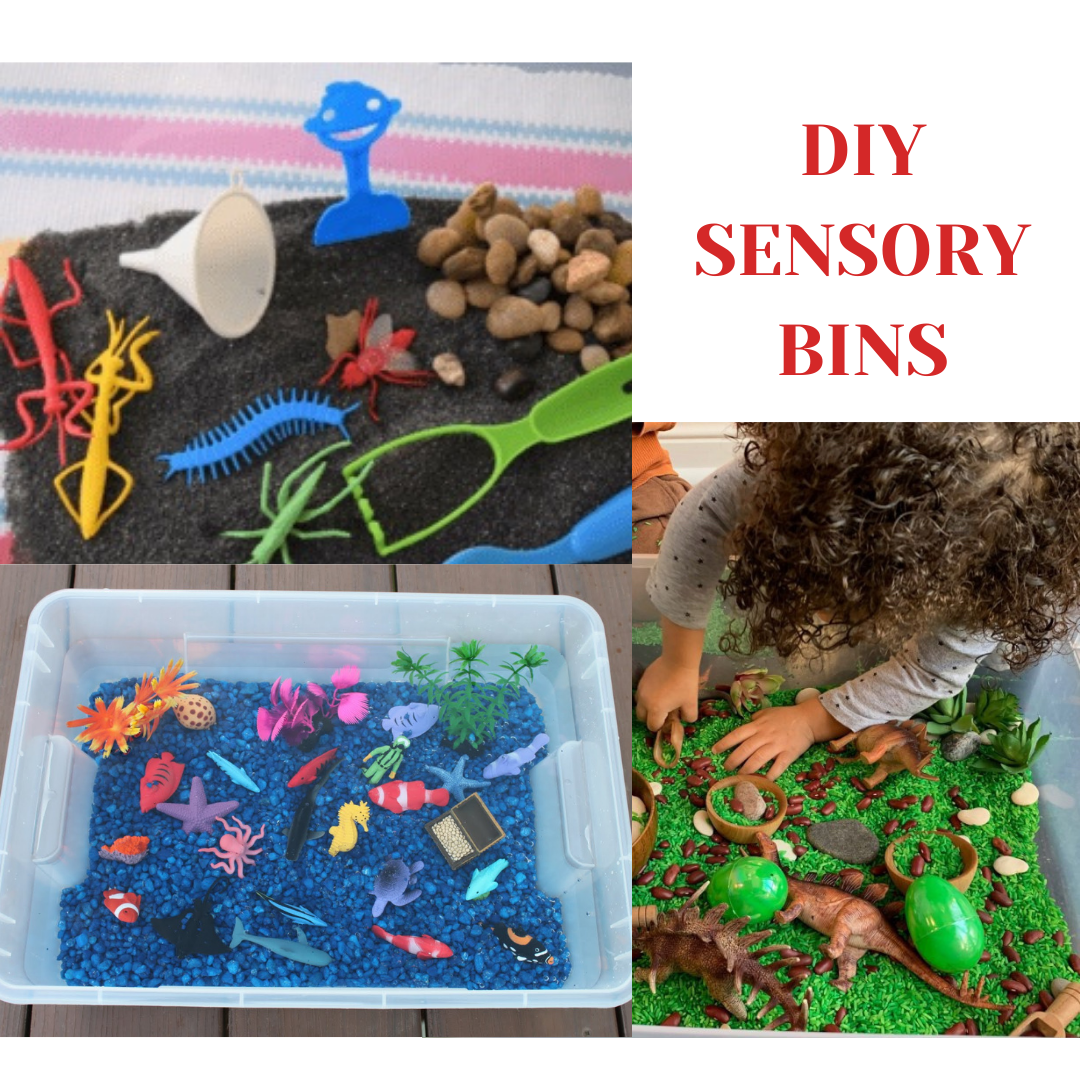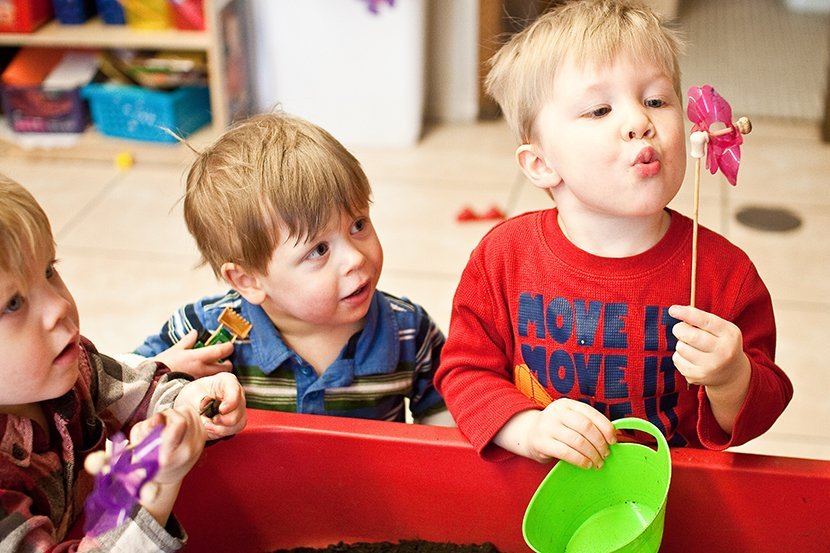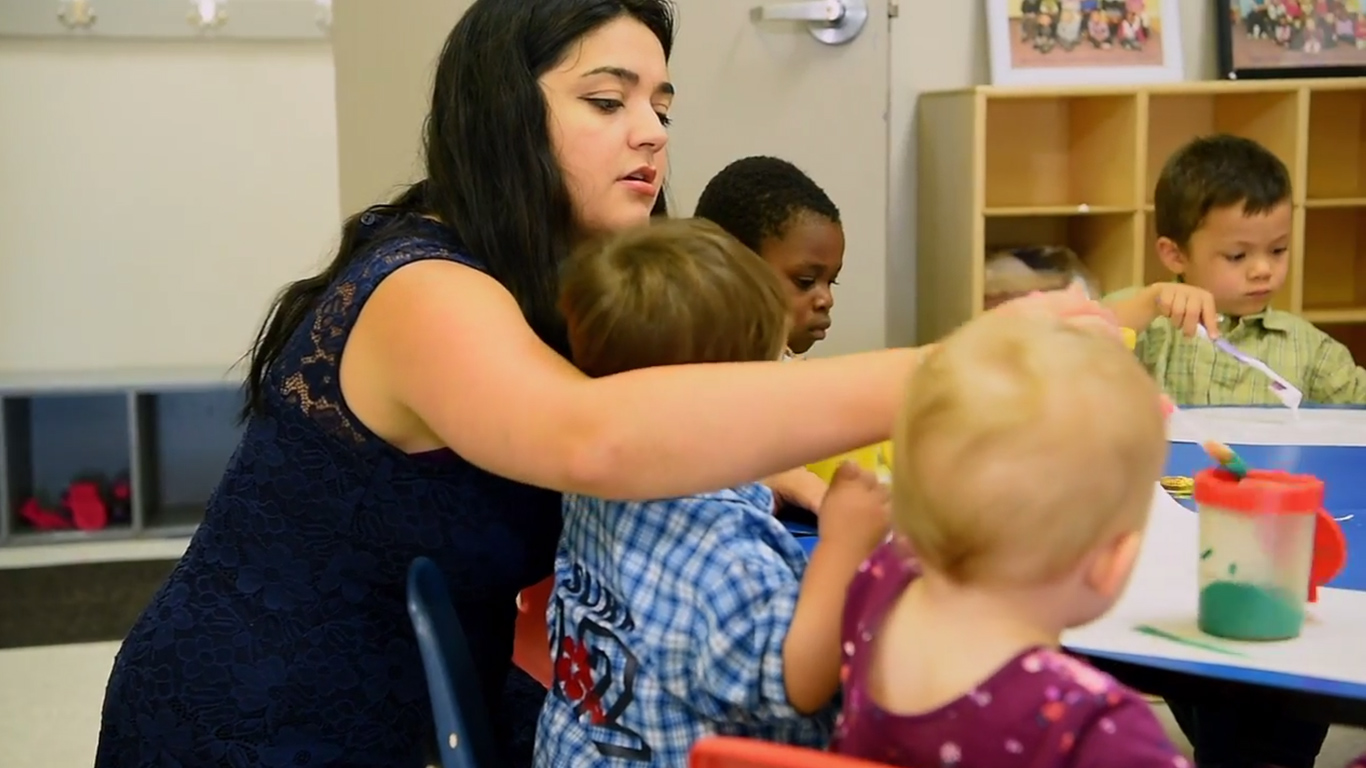DIY Sensory Bins – How to Make your Own Sensory Bin
DIY Sensory Bins – How to Make your Own Sensory Bin
Sensory bins are an amazing educational tool for children to learn about their world using their senses! Young children tend to gravitate toward sensory play as they tend to explore their world with their senses. The benefits of sensory play are numerous. Sensory play helps children to focus, helps them to feel calm and it develops many skills from cognitive to physical to social skills.
Recently, I saw that a local craft store was selling pre-made sensory bins for $25 but you can make your own for a lot less. At Alpha’s Discovery Kids Preschool and Daycare, we make individual sensory bins for each child and change the items in the bins almost every day. Here’s a step-by-step guide to making your own sensory bin.
To make your own sensory bin, you first need to know what it is! A sensory bin is a hands-on sensory experience for kids, in a contained area such as a storage container. It contains many different items that can be explored using your senses.
STEP 1: CHOOSE A CONTAINER
When choosing a container, consider your space and choose something that will fit in your space. The size of the bin will depend on the age of the child, but as a rule, try to find the biggest container that your child can manage. The child should be able to hold the bin and take it from a shelf independently. Plastic clear containers are best with a good lid that seals well. You don’t have to spend a lot on the container as you can usually find them at a dollar store for a few dollars.
STEP 2: CHOOSE THE FILLER
The sensory bin filler is the item that makes the sensory fun. Please note that you can change your filler often – but we recommend at least once per week to make it interesting for your child and keep it clean. Some examples of fillers are: water, sand, rocks, water beads, shredded paper, coloured Epsom salt, play dough, fake grass, fake snow, wooden beads and natural elements (leaves, twigs, soil, seeds). You can also choose food items such as beans, dry pasta and rice but we prefer not to use food items, to minimize food waste. Keep in mind your child’s age and ability when choosing a filler (including potential choking hazards) and ensure that play is always supervised by an adult.
STEP 3: ADD ITEMS
Once you have the filler, the next step is to add items that spark the child’s interest. One of the best parts of sensory bins is all the filling, dumping, pouring and transferring that takes place! When adding items, you are only limited by your own imagination – or your child’s if they choose their own items to add. The items you add will depend on what type of filler – for example, you will have different items if the filler is water vs. wooden beads. Here’s some ideas for items: sifter, sieve, smaller containers, watering can, shovel, buckets, animals, dinosaurs, cars, dolls, spoons, small bowls, rolling pin, cookie shape cutouts, etc. You can also choose a theme for your bin to focus the learning on a specific concept – such as bugs, oceans, or rainbows.
Step 4: HAVE FUN!
The best part of making sensory bins, is getting to enjoy them with your child! We encourage you to play and explore along side your child!
For more information about our Four Pillars of Learning Curriculum, visit our curriculumcurriculum page.
For more ideas on how to engage with your child, visit our Youtube page.
E is for Engineering
At Alpha’s Discovery Kids Preschool and Daycare, we understand the importance of educating children using a wholistic approach. Engineering is a key component of our STEAM (Science, Technology, Engineering, Art and Math) program which is one of our four pillars of learning. You may be wondering how we teach young children engineering skills. This may seem like an abstract concept that young children wouldn’t understand. So first, let’s define engineering and then discuss how we teach those skills to young children.
Engineering is the application of scientific knowledge to solving problems in the real world. Therefore, people use engineering skills to solve problems, which may include learning how things work and building things that we will solve problems in our daily life. So, if you look at it that way, young children are constantly in the process of engineering. They are so inquisitive and they are constantly trying to figure out how things work. It starts with simple tasks, like opening a closed cupboard door or moving a car up and down a ramp. Every activity that they are participating in, is giving them the opportunity to problem solve. One day, these simple little tasks will teach them to solve bigger problems. Teaching children how to think creatively and learning to solve problems prepares them for the future.
Engineering is the process by which young children discover how the things in their world are built and how they work. Whether it is building a block tower, or it is exploring a simple pendulum, engineering is a natural part of everyday, early learning.
Now that we understand what engineering is and how it relates to young children, how do we foster the development of engineering skills. Exploration is a major component when it comes to engineering, so we need to give children opportunities to explore. The ability to freely explore something is important while avoiding too many rules and instructions. This will help the children to solve a problem creatively and lead to understanding and insight.
Another way to foster engineering skills is to let the children play. As parents and educators, we can be over-protective of this generation of children as we try to eliminate any area of risk for them. We fear the slide is too high, that they shouldn’t climb up it. We begin to instill fear in them that isn’t there. Let them play in mud and make mud pies, let them play with sticks and blocks and shovels. Let them be kids and explore. Playing in mud won’t hurt them, it only creates opportunities to problem-solve, create and imagine.
At Alpha’s Discovery Kids, we provide planned activities to the children every day that builds on engineering skills. We provide specific materials to let them build and engineer with. It is important to have a plan and purpose, as well as have the freedom to play and explore. It is okay to create challenges for young children to engineer and build.
Here’s some things you can try at home. Give your child a basket of blocks and challenge them to see how high they can create a tower. Gather rocks outside and create a rock tower. Provide different shapes and sizes of these materials so that they learn what order to place the items in, from biggest to smallest, from fattest to thinnest. It is important to allow the space needed for when the tower does fall, or they make it too tall or too wide.
Provide children with random material in a basket and see what they can build and create. You can put paper, glue, scissors, random craft supplies and let them create and imagine. It is important to ask thought provoking questions along the way. The key is to have one-on-one conversation with your child throughout the engineering process.
Visit our curriculum page for more information about how we incorporate engineering into our four pillars of learning through STEAM curriculum. We have truly developed an exceptional program that focuses on the child as a whole. We believe that language, literacy, STEAM and mindfulness can provide children a path for continuous growth.
Transitioning into Daycare
One of the most emotional things for a parent to experience is the transition from home to daycare. It is so hard to imagine a complete stranger taking care of your child regardless of their qualifications. First of all, you need to know that you are not alone in feeling this way. At Alpha’s Discovery Kids Preschool and Daycare in Mississauga, we want to make the transition to daycare as smooth as possible so here are some tips to make the transition easier. Read more ›
Are you involved in your Child’s Daycare or Child Care Centre?
Are you involved in your Child’s Daycare or Child Care Centre?
Are you involved in your Child’s Daycare or Child Care Centre? – Are you feeling disconnected with your daycare or child care centre? Are you too busy to get involved in your child’s learning? As parents, we know how busy you are and it can be difficult to get involved in your child’s daycare when you have so many competing priorities. Each child care centre uses different ways to engage families with the program; however, you may be wondering how you can get involved? Based on our experience at our Mississauga daycare and child care centre, here’s some ways to connect: Read more ›
Cooking with Kids
Cooking with Kids
Cooking with Kids – The foodie revolution is in full swing—but why should grown-ups have all the fun? From cooking shows starring “junior” chefs to kitchen toys, kids are discovering the culinary arts…and having a blast doing it! Read more ›
The Power of Positivity when Communicating with Kids
Communicating With Kids
“STOP DOING THAT!” “YOU DON’T LISTEN!” “I CAN’T BELIEVE YOU RIGHT NOW!” Some of the things that we as parents say to our children when we are frustrated or upset with them can affect their self-esteem and their opinion of you. Our words are so powerful so we as parents and educators must choose them wisely and try to use positive language as much as possible. Read more ›
Physical Literacy – what is it?
What is Physical Literacy?
Physical Literacy sounds like reading a story while doing a cartwheel; however, it is a term that is both critical to learn and vital for early development for our children. So what is Physical Literacy? Read more ›
We love you too but when it’s time to hit the road……..Alpha’s Awesome Road Trip Tips!
Everyone needs a little holiday now and again and while Alpha’s Preschool Academy loves every member of our toddler, preschool and daycare programs, we know it’s important for families to spend time together too. Often, this means a summer road trip. (Insert groan here, LOL!) If it’s time for your family to take a little road trip adventure vacation, whether to Grandma’s house or Gander, Newfoundland, we’ve got you covered with some helpful travel tips tailor made for children of all ages! Read more ›
Sunscreen and your Child: Everything you ever needed to know – and stuff you didn’t even know you needed to know!
Kids Sunscreen
Right about now you are probably expressing a huge sigh of relief that winter is well behind us and summer fun has begun. Gone are the days of rushing out the door after first bundling them up in coats, boots, hats, mittens and scarves. Some mornings, we’re sure you already felt like you’d run a half marathon, just getting your child safely to daycare and pre-school! Now it’s just shorts, t-shirts and a fight over flip-flops or sandals. Easy-peasy! Or is it? The truth is summer can be just as time-consuming when you factor in the SPF factor. Read more ›
What Parents Should Know Before Starting Daycare or Preschool
Before Starting Daycare
Before Starting Daycare – Putting your child into a daycare or preschool for the first time is difficult for many parents. Parents don’t usually know what to expect. Here’s some things you should know before your child starts to help to make that transition go smoothly. Read more ›








